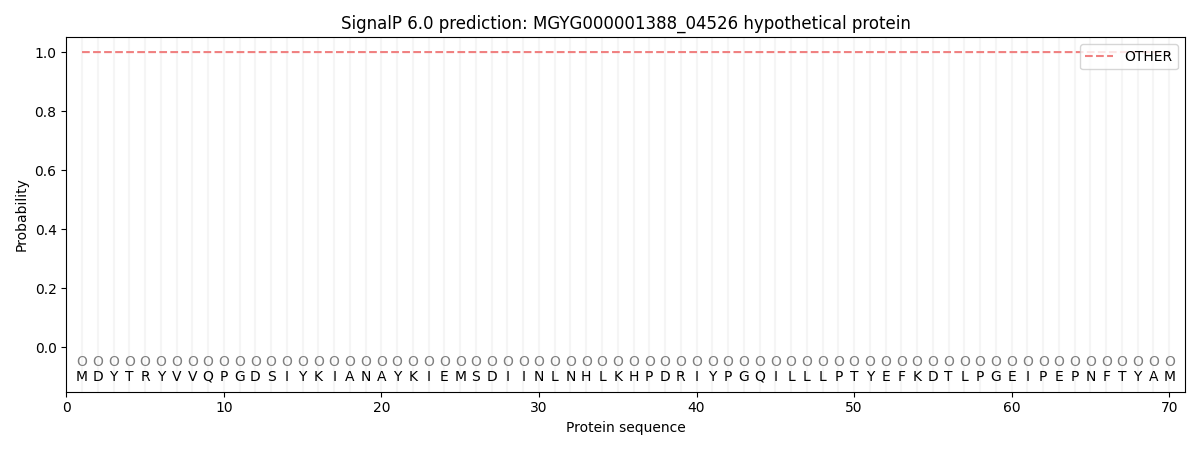You are browsing environment: HUMAN GUT
CAZyme Information: MGYG000001388_04526
You are here: Home > Sequence: MGYG000001388_04526
Basic Information |
Genomic context |
Full Sequence |
Enzyme annotations |
CAZy signature domains |
CDD domains |
CAZyme hits |
PDB hits |
Swiss-Prot hits |
SignalP and Lipop annotations |
TMHMM annotations
Basic Information help
| Species | Desulfitobacterium hafniense | |||||||||||
|---|---|---|---|---|---|---|---|---|---|---|---|---|
| Lineage | Bacteria; Firmicutes_B; Desulfitobacteriia; Desulfitobacteriales; Desulfitobacteriaceae; Desulfitobacterium; Desulfitobacterium hafniense | |||||||||||
| CAZyme ID | MGYG000001388_04526 | |||||||||||
| CAZy Family | CBM50 | |||||||||||
| CAZyme Description | hypothetical protein | |||||||||||
| CAZyme Property |
|
|||||||||||
| Genome Property |
|
|||||||||||
| Gene Location | Start: 388001; End: 388690 Strand: + | |||||||||||
CDD Domains download full data without filtering help
| Cdd ID | Domain | E-Value | qStart | qEnd | sStart | sEnd | Domain Description |
|---|---|---|---|---|---|---|---|
| cd07908 | Mn_catalase_like | 3.12e-30 | 58 | 202 | 4 | 150 | Manganese catalase-like protein, ferritin-like diiron-binding domain. This uncharacterized bacterial protein family has a ferritin-like domain similar to that of the manganese catalase protein of Lactobacillus plantarum and the bll3758 protein of Bradyrhizobium japonicum. Ferritin-like, diiron-carboxylate proteins participate in a range of functions including iron regulation, mono-oxygenation, and reactive radical production. These proteins are characterized by the fact that they catalyze dioxygen-dependent oxidation-hydroxylation reactions within diiron centers; one exception is manganese catalase, which catalyzes peroxide-dependent oxidation-reduction within a dimanganese center. Diiron-carboxylate proteins are further characterized by the presence of duplicate metal ligands, glutamates and histidines (ExxH) and two additional glutamates within a four-helix bundle. Outside of these conserved residues there is little obvious homology. Members include bacterioferritin, ferritin, rubrerythrin, aromatic and alkene monooxygenase hydroxylases (AAMH), ribonucleotide reductase R2 (RNRR2), acyl-ACP-desaturases (Acyl_ACP_Desat), manganese (Mn) catalases, demethoxyubiquinone hydroxylases (DMQH), DNA protecting proteins (DPS), and ubiquinol oxidases (AOX), and the aerobic cyclase system, Fe-containing subunit (ACSF). |
| pfam01476 | LysM | 9.52e-15 | 6 | 49 | 1 | 43 | LysM domain. The LysM (lysin motif) domain is about 40 residues long. It is found in a variety of enzymes involved in bacterial cell wall degradation. This domain may have a general peptidoglycan binding function. The structure of this domain is known. |
| cd00118 | LysM | 1.30e-13 | 4 | 48 | 1 | 45 | Lysin Motif is a small domain involved in binding peptidoglycan. LysM, a small globular domain with approximately 40 amino acids, is a widespread protein module involved in binding peptidoglycan in bacteria and chitin in eukaryotes. The domain was originally identified in enzymes that degrade bacterial cell walls, but proteins involved in many other biological functions also contain this domain. It has been reported that the LysM domain functions as a signal for specific plant-bacteria recognition in bacterial pathogenesis. Many of these enzymes are modular and are composed of catalytic units linked to one or several repeats of LysM domains. LysM domains are found in bacteria and eukaryotes. |
| smart00257 | LysM | 2.18e-13 | 6 | 48 | 2 | 44 | Lysin motif. |
| cd00657 | Ferritin_like | 1.09e-12 | 71 | 199 | 2 | 123 | Ferritin-like superfamily of diiron-containing four-helix-bundle proteins. Ferritin-like, diiron-carboxylate proteins participate in a range of functions including iron regulation, mono-oxygenation, and reactive radical production. These proteins are characterized by the fact that they catalyze dioxygen-dependent oxidation-hydroxylation reactions within diiron centers; one exception is manganese catalase, which catalyzes peroxide-dependent oxidation-reduction within a dimanganese center. Diiron-carboxylate proteins are further characterized by the presence of duplicate metal ligands, glutamates and histidines (ExxH) and two additional glutamates within a four-helix bundle. Outside of these conserved residues there is little obvious homology. Members include bacterioferritin, ferritin, rubrerythrin, aromatic and alkene monooxygenase hydroxylases (AAMH), ribonucleotide reductase R2 (RNRR2), acyl-ACP-desaturases (Acyl_ACP_Desat), manganese (Mn) catalases, demethoxyubiquinone hydroxylases (DMQH), DNA protecting proteins (DPS), and ubiquinol oxidases (AOX), and the aerobic cyclase system, Fe-containing subunit (ACSF). |
CAZyme Hits help
| Hit ID | E-Value | Query Start | Query End | Hit Start | Hit End |
|---|---|---|---|---|---|
| BAE84981.1 | 4.35e-173 | 1 | 229 | 1 | 229 |
| CDX03304.1 | 7.22e-172 | 1 | 229 | 1 | 229 |
| AGA70483.1 | 4.95e-147 | 1 | 228 | 1 | 228 |
| AHF07942.1 | 5.87e-129 | 1 | 211 | 1 | 211 |
| AFQ46039.1 | 8.41e-103 | 1 | 210 | 1 | 214 |
Swiss-Prot Hits help
SignalP and Lipop Annotations help
This protein is predicted as OTHER

| Other | SP_Sec_SPI | LIPO_Sec_SPII | TAT_Tat_SPI | TATLIP_Sec_SPII | PILIN_Sec_SPIII |
|---|---|---|---|---|---|
| 1.000059 | 0.000000 | 0.000000 | 0.000000 | 0.000000 | 0.000000 |
